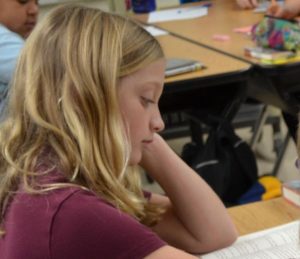 Our Philosophy
Our Philosophy
Fifth graders start growing toward independence but still need guidance, encouragement and support from home. We assist parents in the spiritual, educational and social development of their child as fifth graders prepare for the middle-school adventure.
Classroom procedures require listening during instruction with independent follow-through. On average, fifth graders should plan on 50 to 60 minutes of homework per night. Some of the assignments may be long-term projects like book reports, spelling lessons, etc. These assignments should be worked on during evenings when there is less daily homework or on the weekend if your child works at a slower pace or has many outside obligations during the school week. All assignments should be recorded in an assignment notebook and handed in on time. Getting and staying organized is a life strategy practiced in fifth grade.
Fifth-Grade Curriculum
Religion
The Sacraments series by Spirit of Truth emphasizes the sacraments and their importance in our lives. We study the virtues and how to live a virtuous life. Fifth graders also have the opportunity to altar serve and cantor at weekly school and parish masses.
Reading
A literature-based program is used to help students become successful readers. Systematic instruction helps students develop a variety of strategies and skills, which allows them to apply meaning to what they read. Students also participate in the Accelerated Reader program. Novels are taught using the comprehension strand of Project Read. Research, comprehension, vocabulary, fluency skills as well as dictionary skills are taught. Several genres of books are covered. Students will participate in independent reading, whole-class novel study, and small group book clubs throughout the year.
English/Writing
Basic grammar is covered using the Houghton Mifflin ENGLISH textbook. Grammar concepts include sentence structure and parts of speech. Focusing on the writing process and traits of writing, students will have opportunities to write freely, as well as composing more formal writing projects, including stories, five-paragraph essays, reports, and poetry. Punctuation and capitalization rules are taught, practiced, and enforced.
Spelling/Vocabulary
Zaner Bloser’s Spelling Connections focuses on words fifth graders need to master. Spelling tests are weekly and correct spelling is encouraged in all content areas. Sadlier’s Vocabulary Workshop consists of units highlighting vocabulary words in context, definitions, and synonyms and antonyms.
Social Studies
Harcourt’s Social Studies: The United States introduces students to the people and events that have shaped the United States.
Science
Our curriculum enables students to work at their own level as they master concepts and advance to more challenging levels. In class we use Savvas enVision text as we learn and grow in developing new concepts. Hands on and online activities will be used to supplement learning and develop skills.
Math:
Our curriculum enables students to work at their own level as they master concepts and advance to more challenging levels. In class we use Savvas enVision text as we learn and grow in developing new concepts. Hands on and online activities will be used to supplement learning and develop skills.
Enrichment
Spanish
All St. Francis students learn Spanish. Fifth-grade students continue building vocabulary and beginning reading, writing, and conversation skills. They also learn about the Hispanic culture and Catholic faith with short prayers, songs and traditions.
Specials
In addition to academic classes, children have weekly art, band, computer, physical education, library and music classes.
Fifth-Grade Camp
This is a fun-filled time with an emphasis on environmental education. The YMCA Storer Camp is located near Jackson, Michigan.
Recess/Lunch